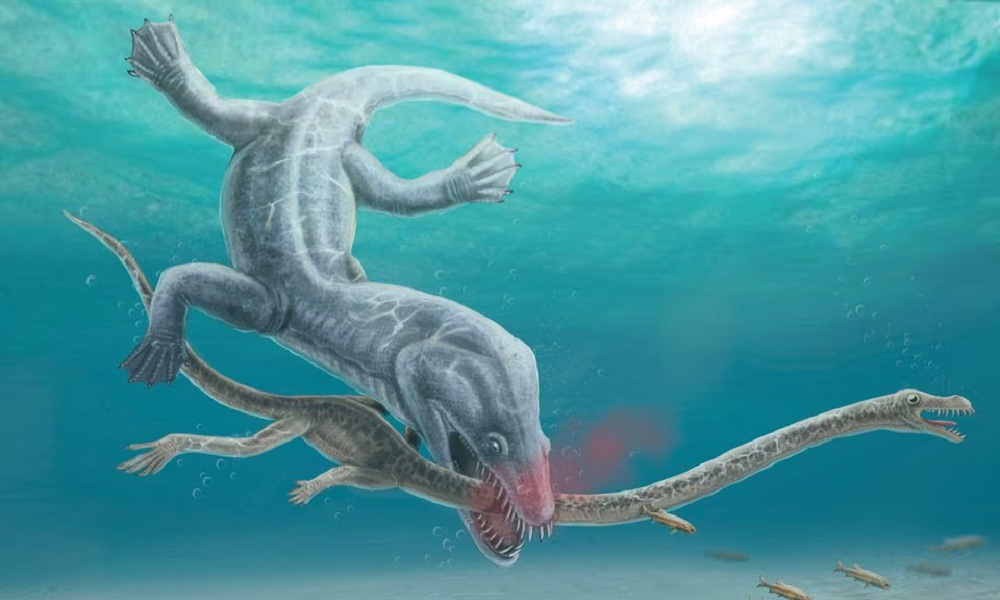Science & Technology
Fossils show ancient long-necked sea beast’s ‘gruesome’ decapitation

In shallow waters about 242 million years ago, a strange marine reptile built unlike any other animal ever on Earth hunted for fish and squid, using an inordinately elongated neck to ambush prey. Suddenly and violently, its life ended – decapitated by a powerful predator.
Scientists for two centuries have suspected that prehistoric marine reptiles like this one, named Tanystropheus, possessing very long necks were highly vulnerable to such attacks.
A fresh examination of Tanystropheus fossils unearthed in Switzerland decades ago on a mountain called Monte San Giorgio has provided the first unambiguous evidence to demonstrate it, Reuters reported.
The researchers studied neck and head remains of two species of Tanystropheus, detecting bite marks and other signs of trauma indicating decapitation.
The larger species, the one that ate fish and squid, reached 20 feet (6 meters) long, though this individual was about 13 feet (4 meters). The smaller species was about 5 feet (1.5 meters) long, with teeth indicating a diet of soft-shelled invertebrates like shrimp.
The neck of Tanystropheus was three times longer than its torso. Useful in hunting, extreme neck elongation was common among marine reptiles spanning about 175 million years during the age of dinosaurs. But this came with a price: an obvious weak spot for predation.
“These very dramatic examples of predator-prey interaction are extremely rare in fossils, and they give us an insight into how these animals lived together. It reminds us that these creatures went through dramatic events similar to what we see in nature today – in this case in a particularly vivid and gruesome way,” said paleontologist Stephan Spiekman of the State Museum of Natural History Stuttgart in Germany, lead author of the research published this week in the journal Current Biology.
The attacker of the bigger Tanystropheus species likely was a large marine reptile, the researchers said, perhaps a species of: Cymbospondylus, 33 feet (10 meters) long; Nothosaurus, 23 feet (7 meters) long; or Helveticosaurus, 12 feet (3.5 meters) long.
Various marine reptiles or predatory fish, they said, could have decapitated the smaller species.
Tanystropheus, appearing during the Triassic Period at a time of evolutionary innovation following Earth’s worst mass extinction, thrived across the northern hemisphere for 10 million years. It was a distant relative of the dinosaurs, which first appeared roughly 230 million years ago.
“We think Tanystropheus spent most of its time in the water, staying in the shallows, using its small head and long neck to ambush prey from the sea floor,” Spiekman said.
“Tanystropheus is so interesting because its body plan is entirely unique in the history of all of life. Sure, there are other animals with a very long neck, but not a neck that is this long, this stiff and this lightweight, with very long, string-like neck ribs. And then what adds to the weirdness and mystery is that the rest of the animal is also puzzling,” Spiekman said.
Science & Technology
Apple loses top phonemaker spot to Samsung as iPhone shipments drop, IDC says

Apple’s (AAPL.O), opens new tab smartphone shipments dropped about 10% in the first quarter of 2024, hurt by intensifying competition by Android smartphone makers aiming for the top spot, data from research firm IDC showed on Sunday.
Global smartphone shipments increased 7.8% to 289.4 million units during January-March, with Samsung (005930.KS), opens new tab, at 20.8% market share, clinching the top phonemaker spot from Apple, Reuters reported.
The iPhone-maker’s steep sales decline comes after its strong performance in the December quarter when it overtook Samsung as the world’s No.1 phone maker. It’s back to the second spot, with 17.3% market share, as Chinese brands such as Huawei gain market share.
Xiaomi, one of China’s top smartphone makers, occupied the third position with a market share of 14.1% during the first quarter, read the report.
South Korea’s Samsung, which launched its latest flagship smartphone lineup – Galaxy S24 series – in the beginning of the year, shipped more than 60 million phones during the period.
Global sales of Galaxy S24 smartphones jumped 8%, compared to last year’s Galaxy S23 series during their first three weeks of availability, data provider Counterpoint previously said.
In the first quarter, Apple shipped 50.1 million iPhones, down from 55.4 million units it shipped same period last year, according to IDC.
Apple’s smartphone shipments in China shrank 2.1% in the final quarter of 2023 from a year earlier.
The drop underscores the challenges facing the U.S. firm in its third biggest market, as some Chinese companies and government agencies limit employees’ use of Apple devices, a measure that mirrors U.S. government restrictions on Chinese apps on security grounds.
The Cupertino, California-based company in June will hold its Worldwide Developers Conference (WWDC), where it will highlight updates to the software powering iPhones, iPads, and other Apple devices.
Investors are closely watching for updates on artificial intelligence development at Apple, which has so far spoken little about incorporating the AI technology into its devices. The company earlier this year lost the crown as the world’s most valuable company to Microsoft (MSFT.O), opens new tab, Reuters reported.
Science & Technology
China launch of relay satellite Queqiao-2 for lunar probe mission successful

China National Space Administration (CNSA) said on Friday its launch of a key signal relay satellite was a “complete success” and it would serve as the communication bridge for its future lunar probe missions for years to come, state media reported.
China launched the satellite Queqiao-2, which was named after a mythological bridge made of magpies, and two miniature satellites, Tiandu-1 and Tiandu-2, on March 20.
Queqiao-2 will be used as a communications bridge between the ground operations on earth and upcoming lunar probe missions on the far side of the moon until at least 2030.
The moon’s near side always faces earth. That means data transfers from the far side are impossible because there is no direct line of sight.
Queqiao-2 researcher and developer Xiong Liang described the satellite as “the main switch” of the whole fourth phase of lunar missions, according to state television CCTV.
“Only when the main switch is flipped on, all the communications can kick off,” Xiong said.
Queqiao-2 will orbit the moon and relay signals to and from the Chang’e-6 mission, which expected to be launched in May. The robotic Chang’e-6 probe will seek to retrieve samples from an ancient basin, acquiring lunar material from the moon’s hidden side for the first time.
Queqiao-2 will also be used as a relay platform for the Chang’e-7 lunar mission in 2026 and the Chang’e-8 mission in 2028.
The functions and performance of Queqiao-2 met mission requirements and it will be able to provide relay communication services for China’s lunar exploration projects and future lunar missions for China and other countries, said the CNSA, according to CCTV.
Queqiao-2 entered its targeted elliptical orbit on April 2 after a correction midway, near-moon braking and orbital manoeuvre around the moon, CNSA said.
The satellite has successfully communicated with Chang’e 4, which was the first spacecraft to perform a soft landing on the far side of the moon and is still carrying out its exploration mission. It also communicated with the Chang’e-6 probe while it is still on the ground earlier this month.
The successful launch of Queqiao-2 comes after the failed launch of another lunar spacecraft DRO-A/B satellites, which was intended to enter the moon’s distant retrograde orbit (DRO).
China has not released any information on whether or not the satellites can be retrieved.
(Reuters)
Science & Technology
Russia aborts planned test launch of new heavy-lift space rocket

Russian space officials on Tuesday aborted the test launch of a new heavy-lift rocket from its far-eastern launch pad.
The Angara-A5 rocket was scheduled to lift off from the Vostochny space launch facility at 0900 GMT Tuesday, but the launch was aborted two minutes before, AP reported.
Yuri Borisov, head of Roscosmos state space corporation, said the automatic safety system canceled the launch after registering a flaw in the oxidizer tank pressurization system.
He said the next launch attempt was set for Wednesday.
Tuesday’s launch was to be the fourth for the Angara-A5, a heavy-lift version of the new Angara family of rockets that has been developed to replace the Soviet-designed Proton rockets.
-

 Latest News4 days ago
Latest News4 days agoRashid Khan named AWCC’s brand ambassador
-

 World4 days ago
World4 days agoMalaysian navy helicopters collide in mid-air, 10 killed
-

 Sport4 days ago
Sport4 days agoJaiswal ton powers Rajasthan to big IPL win
-

 World3 days ago
World3 days agoNorth Korea officials visit Iran in a rare public trip
-

 Sport4 days ago
Sport4 days agoMawj Sahil player scores stunning halfway line goal in 1-0 win over Jawanan Wahedi
-

 Latest News4 days ago
Latest News4 days agoAt least 1,500 families affected by recent floods: IRW
-

 Sport3 days ago
Sport3 days ago‘Serious talent’ Fraser-McGurk bonds with Warner to light up IPL
-

 Latest News4 days ago
Latest News4 days agoUS report cites ‘significant deterioration’ in Afghan women’s rights last year
























